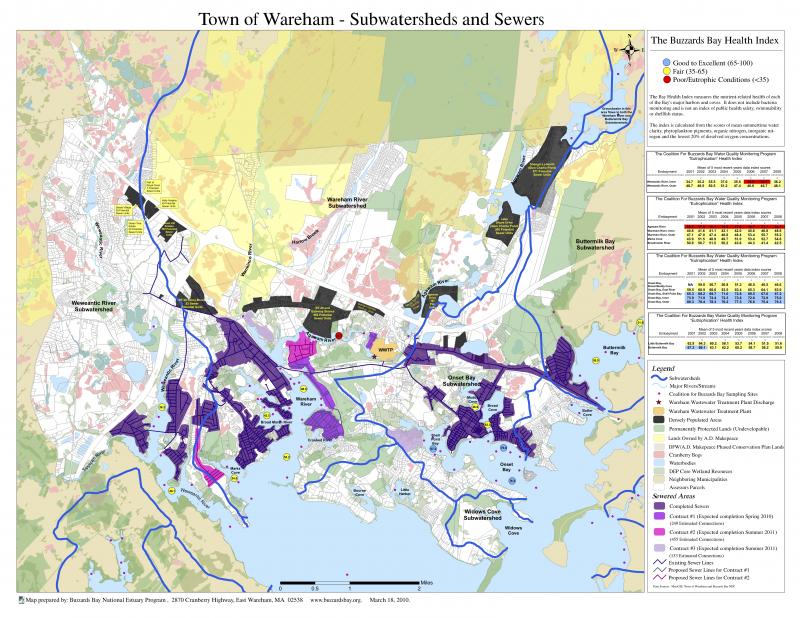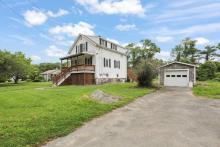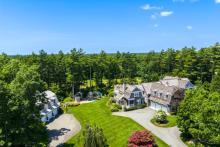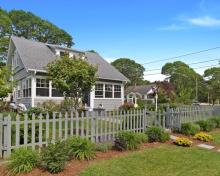In a nutshell: nitrogen
In Wareham, “nitrogen” excites the kind of political passion more generally reserved for things like taxes and crime control.
And the nitrogen controversy will be back at Town Meeting later this month in the form of an effort to repeal a tough new nitrogen bylaw passed by fall Town Meeting.
For those new to town or just tuning in to the issue, here’s a primer on what has both sides – perhaps, more accurately, ALL sides – so excited.
What’s wrong with nitrogen?
Unlike toxic pollutants, nitrogen won’t give you cancer or cause birth defects or make anyone sick. In fact, nitrogen makes things grow, and is the most important ingredient in almost any fertilizer.
It is nitrogen’s ability to make things grow that makes it a problem. When nitrogen gets into streams, ponds, and Buzzards Bay, algae and other “invasive species” love it and grow like crazy. In the process, the algae and their friends suck up a lot of oxygen. Without the oxygen they need, fish and shellfish die.
Where does nitrogen pollution come from?
Being a natural product of all of our bathroom activity, a lot of nitrogen pollution comes from incompletely treated septic waste. The worst polluters are failed septic systems. The town’s sewage treatment plants remove only about 75% of the nitrogen in waste water, according to Water Pollution Control Facility Director Guy Campinha.
Nitrogen also comes from fertilizer: on lawns, on cranberry bogs, on golf courses, etc.
So what’s the controversy?
Here’s where a little history is necessary.
In March 2002, the Town of Wareham reached an agreement with state environmental officials to decrease the amount of nitrogen sent into Buzzards Bay by expanding and improving its sewage treatment plant and extending sewer lines to 12 neighborhoods.
The plant was updated to remove nitrogen in 2005. The sewering began in 2006. Construction is expected to be completed in ten of the neighborhoods by July 31, 2011. The Agawam Beach and Mayflower Ridge sewering projects have yet to go out to bid.
Because the system would not serve all of the town’s residents, it was determined at the time that only those who used the sewer system would pay for it. When a sewer line is extended to a neighborhood, each property owner in that neighborhood is charged a “betterment fee" and every owner of a sewered property pays an annual “sewer user fee.”
With betterment fees now topping $20,000 and the annual user fee at $596 for most households, sewer costs have become extremely controversial. And sewer users pose a couple of fairness questions:
- If clean waterways and a clean Buzzards Bay benefit everyone in town, why are 100% of sewer costs borne by sewer users?
- Why aren’t others who contribute to the nitrogen problem – primarily homeowners not on the sewer system and cranberry growers -- made to do more to decrease their nitrogen output?
The current “net-zero nitrogen” controversy involves an effort to address the second question.
What is net-zero nitrogen?
More history: Those who think non-sewer-users should be doing more to cut down on their nitrogen output have in recent years proposed tough new standards for new construction and vocally criticized cranberry growers. Cranberry growers retorted that they ARE taking steps to put less nitrogen into the watershed, and others complained that the proposed new septic system standards would simply dump a lot of costs onto non-sewer users without taking much nitrogen out of the watershed.
Things seemed headed for a showdown with no compromise possible.
Enter the Coalition for Buzzards Bay, a New Bedford-based nonprofit environmental group dedicated to cleaning up Buzzards Bay, and David Straus, a long time summer resident of Wareham and the founder of Interaction Associates, a firm specializing in getting people together to build consensus around difficult issues.
Over a period of six months, Straus and Coalition staff sat down with advocates of tough new nitrogen standards, cranberry growers, town officials, and concerned citizens and came up with the “Wareham Nitrogen Consensus.” The 41-page action plan contains a list of 15 agreed-upon recommendations to clean up the nitrogen in Wareham’s water.
Among those recommendations is a new “net-zero nitrogen” standard, requiring that developers contribute NO nitrogen to the watershed -- generally by producing very little new nitrogen pollution and then “offsetting” that new amount by decreasing nitrogen pollution elsewhere in town.
No such regulation currently exists anywhere, according to Environmental Protection Agency officials and the Coalition. And it is unclear how a developer who does not have his own “offsets” (i.e. cranberry bogs to take out of production, houses elsewhere to connect to the sewer system) could get to net-zero nitrogen.
“The technology only exists for [nitrogen] to be really low,” said Mark Rasmussen, director of the Coalition for Buzzards Bay.
While acknowledging the difficulties of enforcement, the consensus group did endorse net-zero nitrogen as a goal.
So, if everyone agreed, what’s the issue?
Everyone did not agree that the new standard should immediately be put into effect.
Five months after the consensus group issued its report, a net-zero nitrogen bylaw covering new developments of 10 or more units was submitted by the Board of Selectmen to last fall’s Town Meeting warrant. After contentious debate, it passed by a two-thirds majority, and responsibility was handed to the Board of Health to draft enforcement regulations.
It is now seven months later. The regulations have not been completed. Board of Health members and the Coalition’s Rasmussen cite the difficulties involved in trying to enforce something that has never been enforced anywhere.
And citizen activist Bob Brady has submitted a citizen’s petition to repeal the net-zero nitrogen bylaw as being unenforceable.
And that’s just the background you need to understand the debate!














